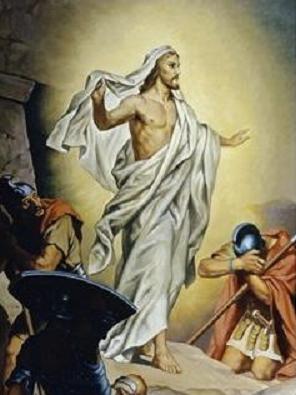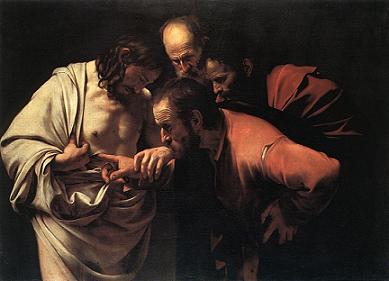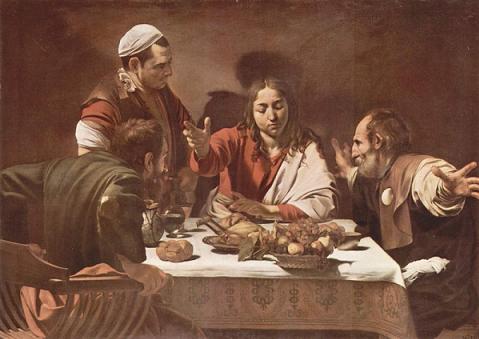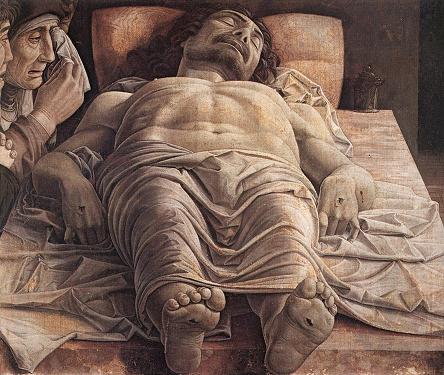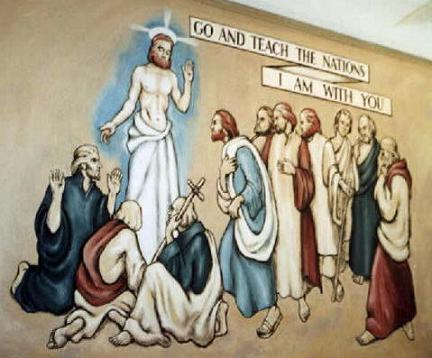|
|
|
|
 |
 |
|
Palm Sunday
Lord Jesus Christ, on the first Palm Sunday
you entered the rebellious city
where you were to die.
Enter our hearts, we pray,
and subdue them to your self.
And as your disciples blessed your coming
and spread garments and branches in your way,
make us ready to lay at your feet
all that we have and are,
that we too may bless your coming
in the name of the Lord.
Amen
|
|
 |
 |
|
OCTAVIO OCAMPO was born in Mexico in 1943 and educated at Mexico City’s Fine Art Institute and the San Francisco Art Institute. He graduated in 1974 and has been exhibiting since then. Primarily working in a metamorphic style, Ocampo uses a technique of superimposing and juxtaposing realistic and figurative details within images. Endlessly fascinating, Ocampo’s paintings reveal more the longer you look. Faces come into focus at a distance and metamorphose into something else entirely viewed close up. It has been said that when viewing Ocampo’s work you are given a glimpse of your preconceptions and how they affect what you see. It is uncanny how what we most need to see appears most prominently to us. Palm Sunday captures the glory of Christ’s entry into Jerusalem, while allowing us to see the face of Christ in whole. Palm Sunday contains 26 faces or figures of people - can you find them all?
|
 |
 |
|
Monday in Holy Week
Almighty God,
your Son Jesus Christ
cleared the temple
of those who desecrated the holy place.
Cleanse our hearts from greed and selfishness,
that we may become the temple of the living God,
the dwelling place of your Holy Spirit;
through the same Jesus Christ our Lord.
Amen
|
|
|
 |
 |
|
JOHANN MICHAEL FERDINAND HEINRICH HOFMANN was born in Darmstadt, Germany in 1824. The eldest of four sons of an advocate of the High Court of Justice, his parents were also gifted artists. Hofmann studied in Dusseldorf and at the Antwerp Academy. His early career was largely centred round portraits of wealthy or influential persons of the time, but in 1854 his painting became deeply religious following the death of his beloved mother. In 1855, he moved to Rome where he spent four years being mentored by the famous German painter Peter von Cornelius. Hofmann was appointed professor at the Academy of Art in Dresden in 1870, where he painted many of his famous works depicting Christ. After thirty years of marriage his wife died in 1891, and Hofmann never recovered from his loss. Shortly after her death, he retired from his post and lived almost as a recluse in Dresden until his death in 1911.
|
|
|
 |
 |
|
Tuesday in Holy Week
Almighty God,
your Son Jesus Christ taught the people
the way of righteousness and judgement.
Grant us a ready mind and willing spirit
to learn from him all that you would teach us,
and keep us watching for his coming
and diligent in his work;
through the same Jesus Christ our Lord.
Amen
|
|
 |
 |
CHRIST AT THIRTY THREE
by HEINRICH HOFMANN
|
 |
|
|
Wednesday in Holy Week
Almighty God,
your Son Jesus Christ withdrew
to the quietness of Bethany
to prepare himself for his passion.
In the fellowship of his suffering,
strengthen us to be more than conquerors
in our trials and temptations,
that whether betrayed by friends
or hurt by enemies,
we remain steadfast in our faith unto the end;
through the same Jesus Christ our Lord.
Amen
|
|
|
 |
 |
|
ANDREA MANTEGNA’S date of birth is uncertain, but thought to be around 1430 in Vicenza, Italy. Local artist and art teacher Francesco Squarcione adopted Mantegna as a ten year old and quickly profited from the talented youngster. At 17, Mantegna broke their agreement and set up on his own working in Padua, Verona and Venice. He married Nicolosia Bellini in 1453, sister of artists Giovanni and Gentile Bellini, whose paintings have been influenced by Mantegna’s style. Ludovico Gonzaga persuaded Mantegna to take up the post of court artist to the Gonzaga family, where he spent the rest of his life working and creating some of his most celebrated work. In 1484 he was knighted, a rare honour for an artist and engraver, and added CP (‘Comes Palatinus’ or Count Palatine) after his name when signing future works. Mantegna died in 1506 and a funeral chapel in the church of Santa Andrea was dedicated in his honour.
‘The Agony in the Garden’ has two versions. The one depicted here is thought to be the later painted in 1459 but still in Mantegna’s early style, showing the moment when Jesus resigned himself to God’s will. His interest in Rome is evident, represented here with an equestrian statue, a column and colosseum-type theatre, in the walled city of Jerusalem. The angels appear while Jesus is praying, bearing the instruments of the Passion (the column of flagellation; the cross of the Crucifixion; the sponge which was dipped in vinegar and the lance used to pierce his side). The disciples sleep while in the background Judas is accompanied by soldiers. The dead tree and vulture may represent death, while the new growth and pelicans could be seen as hope for the future. The rabbits or hares on the path are thought to symbolise defenceless creatures such as those who put the hope of their salvation in Jesus Christ.
|
|
|
 |
 |
|
Maundy Thursday
God our father,
your son Jesus Christ
has left us a meal of bread and wine
in which we share his body and his blood.
When we keep the feast of his redeeming love
may we feed on him by faith,
receive his grace,
and find fullness of life;
through the same Jesus Christ our Lord.
Amen
|
|
 |
 |
|
 THE LAST SUPPER THE LAST SUPPER
by
LEONARDO DA VINCI
LEONARDO DA VINCI was born in 1452 in Vinci, Italy. Born before modern naming conventions, his surname was unrecorded but his father is believed to have been a Florentine notary, named Ser Piero, while his mother a local peasant woman named Caterina. Leonardo da Vinci simply means “Leonardo from Vinci”.
He was remarkably talented, not only as an artist, but as an architect, musician, anatomist, inventor, engineer, sculptor, and geometer. Although he has become famous for his paintings such as the Mona Lisa and The Last Supper, his inventions influenced modern technology such as the helicopter, the tank, use of solar power, and the calculator. However, few of these designs were feasible in his lifetime. He was also instrumental in advancing the study of anatomy, astronomy, and civil engineering. Da Vinci worked for Ludovico Sforza, the Duke of Milan between 1482-1499, and during this time was permitted to have his own workshop and apprentices. It was here that seventy tons of bronze were set aside for his ‘Gran Cavallo’ horse statue, but this never materialised when the Duke ordered the bronze to be cast into weapons to fight against the French in 1495. In 1500, Da Vinci worked as a military architect and engineer for Cesare Borgia, the son of Pope Alexander VI. He travelled and worked extensively in Italy, before finally residing in France working for the French King, Francis I, in 1515 who provided for Da Vinci generously. Da Vinci died in 1519 and sixty beggars followed his casket according to his wish. He was buried in the Chapel of Saint-Hubert in the King’s residence, Chateau Amboise.
Da Vinci was known to leave many projects unfinished, but The Last Supper fresco was finally finished in 1498 after 3 years of painting the 15ft x 29ft refectory wall (dining hall) in the Convent of Santa Maria delle Grazie in Milan. The Last Supper depicts the moments after Jesus announces that one of the disciples will betray him before sunrise. Da Vinci’s version of The Last Supper was the first to display identifiable human emotions among the disciples, and it is said that this is why it has become the most famous painting of this subject. From the left, Bartholomew, James (son of Alphaeus) and Andrew are the first group of three, all aghast at the news with Andrew holding up his hands in a ‘stop!’ gesture. Judas, Peter and John form the next group of three. The face of Judas seems to be in a shadow and he clutches a small bag, thought to be full of silver. Peter is visibly angry, while John seems to be on the point of fainting. Jesus is the central figure - the calm amid the storm. The next group of three are Thomas, James (son of Zebedee) and Philip. Thomas looks agitated, James looks stunned while Philip seems to be seeking clarification. Finally Matthew, Thaddeus and Simon; Simon appears to be offering an explanation to the other two.
Most frescos were painted using egg tempera on wet plaster, however Da Vinci, always the inventor, used dry plaster, resulting in a more varied palette as intended. But unknown to him, this was not at all durable and the plaster began to flake off almost immediately hence the reason attempts have been made to restore it ever since.
|
 |
 |
|
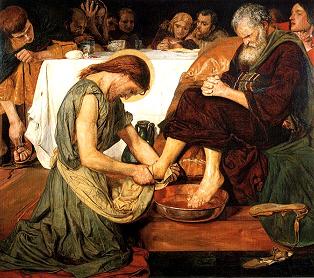 JESUS WASHING PETER’S FEET JESUS WASHING PETER’S FEET
by
FORD MADOX BROWN
FORD MADOX BROWN was born in Calais in 1821 to British parents and trained in Bruges, Ghent, Antwerp and Paris. Settling in London in the mid-1840s his first wife died there in 1846, but in 1853 he was married again to his long-term model Emma Hill. In 1848 he gave Rossetti painting lessons and this led to his close association with Pre-Raphaelitism although he never became a member of the Brotherhood. His most famous paintings are ‘The Last of England’ and ‘Work’, both started in 1852 and finished 3 and 13 years later respectively. In the 1860s Brown worked as an illustrator and furniture and stained glass designer for Morris, Marshall, Faulkner & Co. He died in 1893 having completed a fifteen year project of painting Manchester’s history which can still be seen in Manchester Town Hall.
‘Jesus washing Peter’s Feet’ was exhibited at the Royal Academy in 1852 with a quotation from the New Testament book of St John: ‘[Jesus] poureth water into a basin, and began to wash the disciples’ feet, and to wipe them, with the towel wherewith he was girded...’. Brown originally painted Jesus semi-clad (he later added drapery) and also depicted a woman in the scene. The painting shocked many viewers and remained unsold until 1857 after Brown retouched it removing the woman.
|
 |
 |
|
RAPHAEL SANTI (often known as Rafaello) was born in Urbino, Italy on Good Friday, 6th April 1483. His father raised him and introduced him to art when his mother died in 1491. Various accounts state that at the age of 11, he was apprenticed to the painter Pietro Perugino, however this is disputed. But by the age of 17 it is recorded that he was already called a “master”. His first commission was an altarpiece for a church in 1500. In 1504, he moved to Siena, then Florence, where he would have encountered Leonardo da Vinci and Michelangelo, both known to be working there at the time. At the age of 25 he was commissioned by Pope Leo X and worked for 5 years decorating apartments in the Vatican. Raphael never married, although he was betrothed to Maria Bibbiena (the niece of a Cardinal) in 1514, but she died before they were due to marry.
He painted ‘Christ Falling on the Way to Calvary’ in his last years (1516-1520) and it is now housed in the Museo del Prado in Madrid. Raphael died suddenly in Rome on his 37th birthday in 1520 (reported to be on Good Friday also), apparently only weeks before Pope Leo was to invest him as a Cardinal. His greatness was recognised; he lay in state in one of the rooms he had painted, and was honoured with a public funeral. He was interred in the Pantheon, Italy’s most honoured burial place.
‘Christ Falling on the Way to Calvary’, also known as Sicilia’s Spasimo, was painted for the church of Santa Maria dello Spasimo in Palermo. The church was dedicated to the grief and agony (spasimo) of the Virgin when she witnessed the sufferings of Christ. It is obvious the true subject of Raphael’s painting is indeed the mutual gaze of Jesus, stumbling beneath the weight of the cross, and his distraught mother who reaches out her arms in vain. The attitudes, poses and even glances of the different characters in the painting convey your attention all along the Via Dolorosa, and the standard bearer’s gesture guides the eye towards the left where the crosses are set up. There is a maximum tension between mother and son which draws you to consider the subject deeply. One unconfirmed story regarding this painting is that it was being transported by sea to Sicily and the ship sunk. But the painting floated and drifted into the port of Genoa where monks found it and thought its appearance a miracle. By any means it is a well travelled painting having been bought by Philip IV, King of Spain in 1622 and taken as booty to Paris by Napoleon in 1813 but then returned to Spain in 1822.
|
 |
 |
|
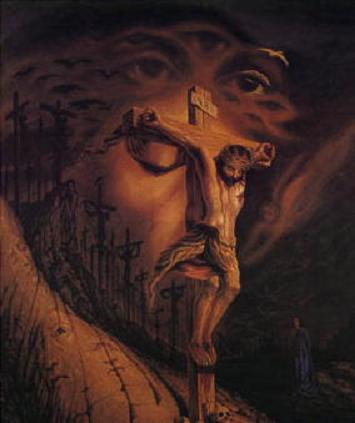 CALVARY CALVARY
by
OCTAVIO OCAMPO
Another stunning painting by OCTAVIO OCAMPO. From the distance the central face of Jesus is heavy with sorrow as he takes on the sins of the world and endures his incredible sacrifice on the cross. Look closer and through the suffering on his face the crucifixion can be seen. The lower left faces are the souls ascending to heaven with the help of angels (middle right) after the gates of hell were opened by Christ’s sacrifice. The crosses to the middle left depict the sacrifices made by Christian martyrs. The ravens in the upper left represent the cares, sorrows and sins of the world. But through the sacrifice and with the help of the Father, Son and Holy Ghost (the three eyes in the upper centre); those ravens are muted and made bearable (below the third eye). The right most eye represents the Holy Ghost, encircled with doves; symbols of peace and love.
Ocampo appears in the work (lower right) representing St. John as well as all of humanity. The blue cloth robe worn by him is a representation of the cloth pressed to the face of Jesus by Veronica on which his countenance was indelibly imprinted. The faint face on this cloth is Veronica’s, crying in anguish for the pain that Jesus had to endure. The story of Veronica is not told in the gospels but in early apocryphal writings. An early 2nd century version of The Acts of Pilate reports that a woman named Veronica (Bernice in the Greek version) was the same woman Jesus cured of a blood disorder (Matthew 9:20-22) and that she came to his trial before Pilate to claim his innocence. Later versions of the story from the 4th and 5th century say that Veronica possessed a cloth imprinted with the face of Jesus. Western pilgrims returning to Europe passed her story on. The Stations of the Cross in Catholicism remember Veronica at the 6th Station: she wipes the face of Jesus on his way to Calvary and he leaves an image of his face on her veil. A healing relic impressed with an image of the face of Jesus which came to be known as ‘Veronica’s Veil’ was honoured in St. Peter’s Church in Rome as early as the 8th century.
|
 |
 |
|
Holy Saturday
O God, creator of heaven and earth,
as the crucified body of your dear Son
was laid in the tomb
and rested on this holy Sabbath,
so may we await with him
the coming of the third day
and rise with him to newness of life;
through the same Jesus Christ our Lord.
Amen
|
|
|
 |
 |
|
Raphael painted the ‘Deposition’ (taking the body of Jesus down from the cross) in 1507. Often known as ‘The Entombment’ it was originally a panel painted in Perugia for Atalanta Baglioni in memory of her son, Grifonetto, who was killed in a Perugian Piazza during a family feud. Later transferred to oil on canvas, it is now housed in the Galleria Borghese in Rome.
While in Florence, the likelihood that Raphael was influenced by Michelangelo is most evident in this painting. Notice the limp arm of Jesus and the female figure to the extreme right who mirrors the virgin in the ‘Tondo Doni’ by Michelangelo in 1505. Unlike other artists of the time, Raphael does not paint the actual deposition itself, but the carrying of Jesus to the tomb. The central characters are also depicted in a less sorrowful way, almost as if resigned to the fact that Christ has been sacrificed.
|
 |
 |
|
The Resurrection of Jesus by Heinrich Hofmann is distinct for two reasons. It is one of the very few resurrection paintings which depicts Jesus without a victory flag or the guards asleep outside the tomb. Little is known of Hofmann’s work or insight into his paintings, even though in artist recording terms he lived until relatively recently (1911) compared to those we have researched from the 15th and 16th centuries. But Hofmann’s portrayal of the gentle and kind-faced Jesus has been featured on many prints, posters and greeting cards, particularly the images featured here for our Monday and Tuesday in Holy Week.
|
 |
 |
|
Second Sunday in Easter
Almighty and eternal God,
the strength of those who believe
and the hope of those who doubt,
may we, who have not seen, have faith
and receive the fullness of Christ’s blessing,
who is alive and reigns
with you and the Holy Spirit,
one God, now and for ever.
Amen
|
|
|
 |
 |
|
Michelangelo Merisi da Caravaggio was raised in Caravaggio, near Milan. The year of his birth is disputed but thought to be 1571 or 1573. He was the eldest son of Fermo Merisi, the household administrator and architect-decorator to Francesco Sforza, Marchese of Caravaggio, and Lucia Aratori, daughter of a local wealthy family. Equally disputed is his place of birth, Caravaggio or Milan, but it is known that the family moved from Milan to Caravaggio in 1576 to escape a great plague where sadly his father died shortly after. In 1584 he spent 4 years as apprentice to Simone Peterzano of Milan who had been a pupil of Titian.
Much of Caravaggio’s adult life and career is steeped in controversy. His paintings caused a furore as much for their radical subject choice as for their depiction of particularly vulgar and shocking scenes. Many religious commissions were rejected and had to be retouched before being allowed to grace the walls of the huge new churches being built in Rome in the late 16th and early 17th centuries. Caravaggio worked in Rome, Naples, Malta and Sicily between 1593 and 1610, and in each location met (or caused) trouble often with fatal consequences for those who engaged in an argument with him. In 1606 he killed a young man in a brawl in Rome and fled to Naples with a price on his head. While there he lived under the protection of the powerful Colonnas family but even then an unsuccessful attempt was made on his life from unidentified enemies. A few months later Caravaggio moved to Malta, and was within a short time inducted as a knight in the Knights of Malta. His popularity was short lived when he was imprisoned in Malta’s harbour castle for a month and expelled from the Order. The circumstances of his crime have been greatly debated but incredibly Caravaggio managed to escape from the prison, and the island, seeking solace in Sicily where he made further enemies before returning to the Colonnas in Naples. Through their influence Caravaggio sought a pardon from Pope Paul V in order to return to Rome. This was imminent in July 1610 and he made his way by boat to Rome, but never arrived. His demise is subject to much confusion and conjecture but the most likely scenario is that he died of fever. At 38 years old Caravaggio was at the height of his career and one of Italy’s most famous artists, but following his death his work was all but forgotten until the late 20th century.
‘The Incredulity of Saint Thomas’ painted in 1601 is one of Caravaggio’s most physically shocking. Eventually purchased by Vincenzo Giustiniani (joining the Prussion Royal Collection) it was housed in Potsdam, Germany where fortunately it survived the wars intact. This painting depicts St John’s Gospel (20:24-29) as Thomas demands to touch the wounds of Jesus before being convinced that the other Apostles have seen him in the flesh. Although the Bible does not actually state that Thomas touched the wounds rather than just seeing them, Caravaggio’s painting has been copied 22 times since the 17th century and this scene is widely accepted in the religious art world.
|
 |
 |
|
Caravaggio painted ‘Supper at Emmaus’ in 1601 for the Roman nobleman Ciriaco Mattei, who later sold it to Cardinal Scipione Borghese. It is now in the National Gallery, London.
The two disciples seated with Jesus at the table have been suggested to be Cleopas and Luke. They walked with Jesus to a town called Emmaus near Jerusalem, but did not recognise the risen Christ. On arrival they invited him to eat with them. According to St. Luke (24:30) when Jesus took, blessed, and broke the bread, they instantly recognised him. In the painting Cleopas has torn clothes while Luke wears the scallop shell of a pilgrim (a souvenir of the shrine of St. James at Santiago de Compostela in Spain). Caravaggio shows his expertise in the perspective of Luke’s extended arms, an artistic challenge for any painter. The servant meanwhile looks unfazed by the event, his smooth forehead and face in the shadow with no obvious facial expression.
There are a number of points to notice in this painting. The dark and blank background is unusual for this period. The basket of food teeters perilously on the edge of the table, a suggestion that this is similar to the world the apostles lived in. Although the disciples are believed to be Cleopas and Luke, the similarity of Cleopas to Thomas in ‘The Incredulity of Saint Thomas’ probably only shows that Caravaggio favoured particular models (the other disciples are not named in ‘The Incredulity of Saint Thomas’ but both paintings show the same men - probably due to the fact they were both painted in 1601). But most unusually, Jesus is painted without a beard. It has been suggested this represents St. Mark’s account (16:12) of Jesus appearing in another form, and of course without his beard would have been less recognisable to his disciples.
Caravaggio always aiming to be controversial, achieved this once again. Five years later he repainted the scene with a bearded Jesus, in a much more restrained version with less animated gestures and muted colours. In 1606 Caravaggio had fled Rome with a price on his head and perhaps the difference in style reflects his personal circumstances at the time.
|
 |
 |
|
Fourth Sunday in Easter
God of peace,
who brought back from the dead our Lord Jesus,
the great shepherd of the sheep,
through the blood of an eternal covenant,
make us perfect in goodness
so that we may do your will;
and create in us what is pleasing to you;
through the same Jesus Christ our Lord.
Amen
|
|
|
 |
 |
|
The date Andrea Mantegna painted the Lamentation over the Dead Christ is debated, but thought to be between 1457 and 1501. The body of Jesus lies on a marble slab, mourned over by his mother Mary, John and Mary Magdalene. His disciple John to the front left with clasped hands and tears on his face looks grief stricken. In the centre, his ageing mother Mary attempts to stem her streaming tears while just out of vision in the top corner Mary Magdalene’s mouth is slightly agape, seemingly gasping. This painting invokes a real sense of pathos. The grief is almost tangible in the light and dark hues and the perspective of the painting shortens Christ’s body but enhances his anatomy. Mantegna’s attention to anatomical detail is acute; the wrinkles on Mary’s face, the frown on the face of Jesus and the torn skin around the nail holes in his hands and feet, not to mention the way the damp shroud moulds around the dried wounds on his legs. An onyx ointment jar is visible to the right of the pillow while an opening to a dark room is visible in the right hand corner, both signs of the imminent entombment.
This painting was found in Mantegna’s studio by his sons after their father’s death and was probably painted for his own personal funerary chapel. At Mantegna’s funeral it hung on his cataflaque and was later sold to Cardinal Sigismondo Gonzaga to pay debts. In 1824 it was acquired by the Pinacoteca di Brera in Milan where it remains.
|
|
|
 |
 |
|
Fifth Sunday in Easter
Almighty God,
your Son Jesus Christ
is the way, the truth, and the life.
Give us grace to love one another
and walk in the way of his commandments,
who lives and reigns
with you and the Holy Spirit,
one God, now and for ever.
Amen
|
|
 |
 |
|
Tiziano Vecellio, better known as Titian, was born near Belluno in Italy. His date of birth is disputed but thought to be around 1488. He was one of four children to his mother Lucia and father Gregorio, a distinguished councillor and soldier. His brother apprenticed 10 year old Titian to Sebastian Zuccato, a celebrated mosaicist in Venice. The most noted artist in Venice at the time was Giovanni Bellini and Titian entered his studio at 15 years old, where he met other protégés of his own age, including Giorgio de Castelfranco (Giorgione). Titian and Giorgione entered into partnership, particularly frescos commissioned by the state to Giorgione in 1508. Due to this partnership, their early works have been difficult to distinguish. Giorgione died suddenly in 1510 and Titian finished many of his works, having obtained a broker’s patent in the Fondaco de Tedeschi (state-warehouse for the German merchants). This patent was a much coveted privilege and exempted Titian from certain taxes as well as yielding him 20 crowns annually. He became superintendent of the government works and was bound to finish incomplete paintings. Bellini died in 1516 and Titian became, for the next 60 years, the unrivalled official master of Venetian art.
Titian married Cecilia in 1525 and had four children, the last of which resulted in Cecilia’s death in childbirth in 1530. For the next 20 years Titian’s artistic style became dramatic, painting many war battle scenes. In 1532 after completing a portrait of Charles V in Bologna, he was made a count palatine and a Knight of the Golden Spur, while his children were made nobles of the empire, which for a painter was an exceptional honour. In 1546, following Michelangelo, Titian was given the freedom of Rome.
For the last 25 years of his life, he became absorbed with perfection and was highly self-critical, often returning to paintings over a period of 10 years to retouch them. In 1576, at nearly 90 years old, Titian died of a plague which was ravaging Venice at the time and he was the only victim of the disease to be given church burial. No memorial marked his grave at the Santa Maria Gloriosa dei Frari until by Austrian command, the Italian sculptor Antonio Canova was commissioned. Soon after Titian’s death, his son also succumbed to the same illness. Titian was a wealthy old man by the time of his death and his sumptuous mansion was plundered by thieves during the plague.
Titian painted ‘Noli Me Tangere’ circa 1512, omitting many of the references which other artists traditionally used to help identify the scene of Mary Magdalene recognising the risen Christ, according to St. John. There is no tomb, no herald angel, no halo or standard in Jesus’ hand marked with a cross. Instead Titian places a hoe in Jesus’ hand referring to Mary mistaking him as a gardener at first, and in Mary’s hand he places a jar of ointment for his imminent burial. Titian ensures Giorgione’s influence is remembered through the rolling landscape and his play on light, while he truly captures the human gesture of Mary attempting to touch Jesus, who recoils with “Don’t touch me”. Titian’s ‘Noli Me Tangere’ is in the National Gallery in London.
|
 |
 |
|
Sunday before Ascension
Merciful God,
you have prepared for those who love you
such good things as pass all understanding.
Pour into our hearts such love toward you,
that we, loving you above all things,
may obtain your promises,
which exceed all that we can desire;
through Jesus Christ our Lord,
who is alive and reigns
with you and the Holy Spirit,
one God, now and for ever.
Amen
|
|
|
 |
 |
|
The Ascension is one of five murals painted during WWII by Bombardier Stanley Warren, a British POW held in Singapore’s notorious Changi Prison. Four Padres, also POWs, the Reverends Stallard, Chambers, Duckworth and Pain, encouraged Warren to paint murals in their makeshift chapel, part of the Roberts hospital block. The remarkable story of The Changi Murals is humbly described in a website “dedicated to all servicemen, servicewomen and civilians of all nationalities, who suffered and who died as the result of being ‘Guests’ of the Emperor of Japan, 1941-1945”. Please visit The Changi Murals website. Padre Chambers did not survive the POW camp. Bombardier Warren died in England in 1992.
|
|
|
 |
 |
 |
|
Ascension Day
Almighty God,
your Son our Saviour Jesus Christ
ascended far above all heavens
that he might fill all things.
Grant that your Church on earth
may be filled with his presence
and that he may remain with us always,
to the end of the world;
through the same Jesus Christ our Lord,
who is alive and reigns
with you and the Holy Spirit,
one God, now and for ever.
Amen
|
|
|
Andrea Mantegna was commissioned by the Gonzaga of Mantua in the 1460s to paint The Triptych, which went on to become one of Mantegna’s most famous works. A hinged three panel altarpiece, The Triptych features the Adoration of the Magi, the Circumcision and the Ascension. It was completed in 1464 but dismantled at a later date, remaining this way throughout the centuries until it was reassembled in the 19th century and hung in the in the Uffizi Gallery in Florence, Italy where it remains today.
|
|
 |
 |
THE ASCENSION
by ANDREA MANTEGNA
|
 |
 |
|
|
Sunday after Ascension
Almighty God,
you have raised your only Son
to the right hand of your glory,
and bestowed on him the name above all names.
Assure us that as he reigns with you in heaven
so he abides with us on earth to the end of time;
through the same Jesus Christ our Lord
who lives and is glorified
with you and the Holy Spirit,
one God, now and for ever.
Amen
|
|
|
|
THE PENTECOST
by TITIAN
The great master Titian painted ‘The Pentecost’ circa 1545 in Venice for the friars of Santo Spirito. It was the altarpiece of the high altar, however it deteriorated very quickly and following an extended litigation period, Titian painted it for a second time.
In 1630 the Senate of Venice decreed that if the city was delivered from the devastating plague which had wiped out a third of their townspeople, a new great church would be built and dedicated to the Virgin Mary. A 26 year old architect, Baldassare Longhena, was given the project and designed the Basilica di Santa Maria della Salute (Basilica of St. Mary of Health/Salvation) commonly known as the Salute. The church was finished in 1631 and Longhena died the year after. Titian’s Pentecost was hung in the nave where it remains today.
Titian depicts Acts 2:1-4 in his scene “And when the day of Pentecost was fully come, they were all with one accord in one place. And suddenly there came a sound from heaven as of a rushing mighty wind, and it filled all the house where they were sitting. And there appeared unto them cloven tongues like as of fire, and it sat upon each of them. And they were all filled with the Holy ghost...” Titian clearly captures the descent of the Holy Spirit as described in Acts. Those present in Titian’s painting are believed to be Mary, mother of Jesus, Mary of Cleophas (Mary’s sister), Mary Magdalene and the Apostles. God, the Father, is depicted in the image of fire and the Holy Spirit as a white dove.
|
|
|
|


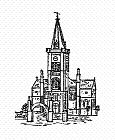
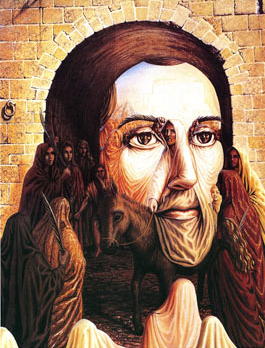
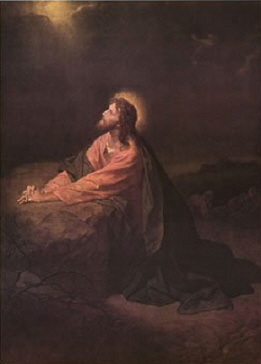



 THE LAST SUPPER
THE LAST SUPPER JESUS WASHING PETER’S FEET
JESUS WASHING PETER’S FEET
 CALVARY
CALVARY
